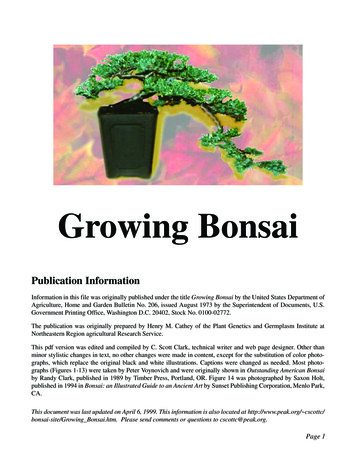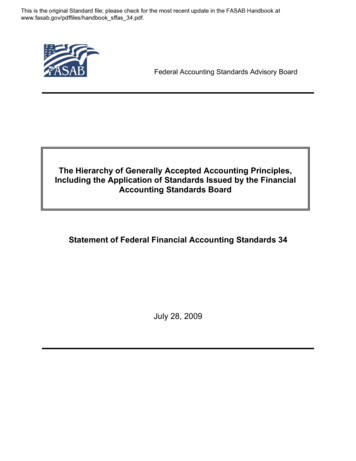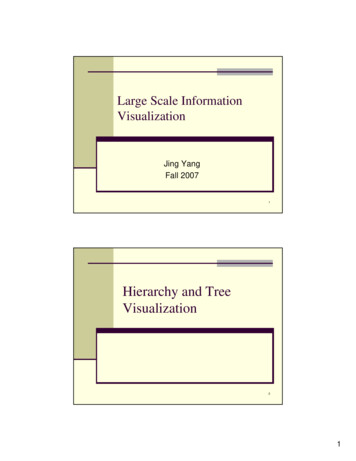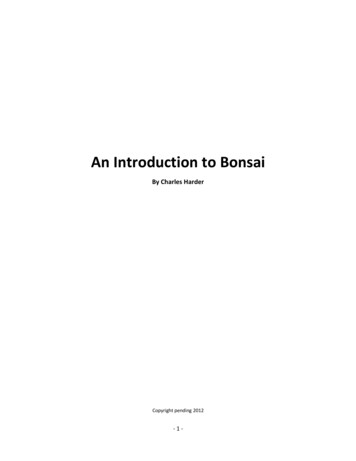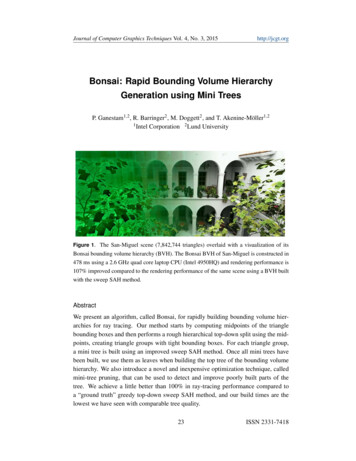
Transcription
Journal of Computer Graphics Techniques Vol. 4, No. 3, 2015http://jcgt.orgBonsai: Rapid Bounding Volume HierarchyGeneration using Mini TreesP. Ganestam1,2 , R. Barringer2 , M. Doggett2 , and T. Akenine-Möller1,21 Intel Corporation 2 Lund UniversityFigure 1. The San-Miguel scene (7,842,744 triangles) overlaid with a visualization of itsBonsai bounding volume hierarchy (BVH). The Bonsai BVH of San-Miguel is constructed in478 ms using a 2.6 GHz quad core laptop CPU (Intel 4950HQ) and rendering performance is107% improved compared to the rendering performance of the same scene using a BVH builtwith the sweep SAH method.AbstractWe present an algorithm, called Bonsai, for rapidly building bounding volume hierarchies for ray tracing. Our method starts by computing midpoints of the trianglebounding boxes and then performs a rough hierarchical top-down split using the midpoints, creating triangle groups with tight bounding boxes. For each triangle group,a mini tree is built using an improved sweep SAH method. Once all mini trees havebeen built, we use them as leaves when building the top tree of the bounding volumehierarchy. We also introduce a novel and inexpensive optimization technique, calledmini-tree pruning, that can be used to detect and improve poorly built parts of thetree. We achieve a little better than 100% in ray-tracing performance compared toa “ground truth” greedy top-down sweep SAH method, and our build times are thelowest we have seen with comparable tree quality.23ISSN 2331-7418
Journal of Computer Graphics TechniquesVol. 4, No. 3, 2015Bonsai: Rapid Bounding Volume Hierarchy Generation using Mini Treeshttp://jcgt.org1.IntroductionIn order to ray trace [Whitted 1980] a scene with path tracing [Kajiya 1986], for example, a spatial acceleration data structure [Kay and Kajiya 1986; Pharr and Humphreys2010] needs to be built. The task of this structure is to speed up the determination ofwhat a ray intersects in a three-dimensional scene. One of the most popular spatialacceleration data structures is the bounding volume hierarchy (BVH). For animatedscenes, the entire BVH, or parts of it, needs to be rebuilt every frame, and therefore,the BVH generation needs to be fast. However, it is also important that the generated trees are of high quality so the subsequent ray-tracing process becomes as fast aspossible.Top-down, greedy sweep surface area heuristic (SAH) methods [MacDonald andBooth 1990], simply abbreviated sweep SAH here, are known to generate high-qualitytrees. We present a highly efficient implementation of the sweep SAH method anduse that as a building block in our new algorithm for generating BVHs. Our algorithmis surprisingly simple, parallelizes well, and is easy to implement. As we will showin our results, our BVHs can be built faster than binning SAH methods [Wald 2007],and our tree quality is better in that the subsequent ray tracing is faster.In Sections 2 and 3 we review previous work and BVH generation background. InSection 4, we present our implementation of the sweep SAH method with some extraoptimizations, followed by our novel BVH generation algorithm. Implementationdetails are described in Section 6 and results are presented in Section 7. Finally, weoffer some conclusions.2.Previous WorkAn important component of light transport simulation performance is the time it takesa ray to find the surface intersection. Tremendous gains in ray-tracing performancehave been achieved through improved traversal algorithms and improved data structures. One of the first uses of hierarchical storage was presented by Clark [1976], whoused them to improve the determination of visible surfaces. Later Rubin and Whitted [1980] developed this idea using parallelepipeds for ray tracing. To ensure that thebest hierarchy was constructed, Goldsmith and Salmon [1987] presented the surfacearea heuristic (SAH) that computes the surface area for new nodes to find the bestpotential split of a bounding volume. MacDonald and Booth [1990] later formalizedSAH. Walter et al. [2008] used SAH to build trees using a bottom-up, node-mergingapproach, but this approach requires long execution times. Recently, Gu et al. [2013]demonstrated a real-time, multi-threaded CPU approximation to Walter et al.’s agglomerative clustering algorithm. While showing impressive results, we show in ourresults, using their provided source code, that our top-down algorithm running on amulti-threaded CPU can build and trace scenes faster.24
Journal of Computer Graphics TechniquesVol. 4, No. 3, 2015Bonsai: Rapid Bounding Volume Hierarchy Generation using Mini Treeshttp://jcgt.orgAila et al. [2013] extended the SAH metric by proposing additional quality metrics for tree construction and, hence, improved ways to measure ray-tracing performance. They introduced two terms—the first term accounted for the fact that manyrays start or terminate inside the scene, whereas SAH assumes they do not. Theycalled the first term end-point overlap (EPO); it takes into account the area of thesurfaces within each node. Second, they showed how to model SIMD performanceby taking into account the number of leaf nodes intersected by a ray, using their leafcount variability (LCV) term. LCV is computed as ray tracing is performed, whichmakes it a good measure for explaining performance, but impractical for BVH construction.The construction of BVHs typically follows a top-down approach where a bounding volume of the entire object is split into two child volumes. These child volumesare recursively split, and before splitting, the SAH is used to estimate the cost of eachpotential split. While this type of exhaustive search can generate trees with very lowSAH cost, it can take a very long time, so faster methods are often used. A popularapproximation is binned SAH [Wald 2007; Wald 2012], which limits the number ofpotential split planes to a fixed number.To further improve performance and utilize the parallel capacity of GPUs, Lauterbach et al. [2009] presented a technique called linear BVH (LBVH), which constructed a BVH by first generating a Morton code for each primitive, then usinga parallel GPU algorithm to sort them, and finally recursively bucketing primitivesbased on the bits in their Morton codes. HLBVH [Pantaleoni and Luebke 2010]improved this technique by using a two-level hierarchical sort that used the upperbits of the Morton code to do an initial sort. Pantaleone et al. [2010] used a similartwo-level build approach in their stream-based out-of-core BVH construction algorithm. Garanzha et al. [2011a] simplified the bookkeeping for the HLBVH algorithmand used work queues and binary search. Karras [2012] improved parallel construction time of this group of algorithms by creating node indices and keys using a binary radix tree that allowed creation of connections between parent and child nodes.A related hierarchical GPU-based approach is presented by Garanzha et al. [2011b].In their work, a hierarchical grid is computed over the scene and used to construct theBVH using SAH.Triangle splitting is an important technique to handle difficult scenes with a widevariety of triangle sizes. Havran and Bittner [2002] presented the idea of split clipping, where the bounding box of an object is split to reduce empty overlap betweenobject bounding boxes and kd-tree nodes. Ernst and Greiner [2007] applied a similarconcept to BVHs by splitting triangle bounding boxes in a preprocess, before using atypical BVH construction pass. Stich et al. [2009] and Popov et al. [2009] proposedsimilar ideas, where primitives are considered for splitting into children during BVHconstruction, which resulted in tighter bounding boxes on a larger range of trianglesthan previous approaches.25
Journal of Computer Graphics TechniquesVol. 4, No. 3, 2015Bonsai: Rapid Bounding Volume Hierarchy Generation using Mini Treeshttp://jcgt.orgFurther performance enhancement can be achieved by optimizing existing trees.Kensler [2008] presented a method of improving a BVH by locally rearranging nodesor using tree rotations. Bittner et al. [2013] also refined existing BVHs by selectingexpensive SAH nodes for optimization, removing them, and then reinserting theirchildren at locations with minimal cost. Karras and Aila [2013] selected groups ofnodes in treelets and performed an exhaustive search for the optimal treelet in parallelon GPUs.3.Background BVH GenerationAs background, we first review the surface-area heuristic (SAH) [Goldsmith andSalmon 1987; MacDonald and Booth 1990], which is used extensively in spatial datastructure generation. The SAH cost for a bounding volume hierarchy (BVH), withsimilar notation as Karras and Aila [2013], isA(n)A(n)A(n) CL CT N(n).A(root)A(root)A(root)n In Ln LCI (1)This formula expresses the expected cost of traversing a random ray through the BVH,such that the ray does not terminate inside the scene geometry. The set of internalnodes is denoted by I, and L is the set of leaf nodes. The function A computes thesurface area of a node’s bounding volume and the function N represents the number oftriangles in a leaf node. The constants CI and CL are the traversal costs of an internalnode and a leaf node, respectively, and CT is the cost for intersecting a triangle. Karrasand Aila use CI 1.2, CL 0, and CT 1.To determine the SAH cost of a node, n, we use the standard formulation, wherewe again use a similar notation as Karras and Aila [2013], i.e.,(CI A(n) C(nl ) C(nr ), n I,C(n) CT A(n)N(n),n L.The left and right child nodes are denoted nl and nr , respectively. Note that the firstformula is an expression of splitting n into a left and a right child, while the secondrepresents the cost of making a leaf node of the triangles.4.Our Implementation of Sweep SAHThe sweep SAH BVH algorithm was introduced by MacDonald and Booth [1990],and one often uses a top-down, greedy approach to build such trees. Sweep SAHis commonly used as a comparison algorithm due to its high-quality trees. However, most implementations seem relatively slow. In this section, we will adapt apartitioning trick from kd-tree building to BVHs and then describe a very efficientimplementation.26
Journal of Computer Graphics TechniquesVol. 4, No. 3, 2015Bonsai: Rapid Bounding Volume Hierarchy Generation using Mini Treeshttp://jcgt.orgSweep SAH is a top-down recursive algorithm that, at each recursion, tries topartition a set of primitives into two subsets that minimize the surface area heuristic.The initial set to be partitioned is all primitives in the scene, and recursion stopswhen a partition cannot improve the cost of the tree. The SAH metric is minimizedby sweeping over primitives along the x-, y-, and z-axis. For this sweep to work,primitives need to be sorted along each coordinate axis. Typical implementations dothis by sorting the primitives along the axis to test before each sweep. However, wehave discovered that this is unnecessary work.In the spirit of previous work on kd-tree building [Wald and Havran 2006; Zhouet al. 2008; Wu et al. 2011], we sort all primitives once along each coordinate axisbefore any recursion takes place and keep these three arrays sorted within each subsetduring recursion. This allows us to improve performance without sacrificing treequality, which is in contrast to the binned SAH approach [Wald 2007], where qualityis often reduced. The sweep part of the algorithm simply performs a sweep overthe correctly sorted array, so no additional sorting is required. Once the partitionthat minimizes the SAH metric is found, we need to ensure that all three arrays arecorrectly partitioned and sorted within the two subsets.Without loss of generality, we assume that x is the coordinate axis along whichwe chose to partition the primitives. This means that the y- and z-arrays need to havethe same primitives in each subset as the x-array, but ordered by the y- and z-axiswithin each subset. We do this by flagging all triangles depending on which side ofthe pivot they are on along x. Then, using this flag, a partition of the primitives in yand z is performed, while preserving order. Partitioning is a fast and simple operationthat runs in O(n) time. This is in contrast to any comparison-based sorting algorithm,which would take O(n log n) time at best. Thus, the sweep recursion is improved fromrunning in O(n log2 n) time to instead execute in O(n log n) time.In addition to the algorithmic improvements, we have found that many parts ofthe SAH algorithm lends itself well to vectorization and threading. Instruction-levelparallelism and SIMD is exploited during SAH minimization by sweeping over multiple triangles at the same time. In our implementation, we successfully utilize 8-wideAVX2 instructions for the sweep. Thread-level parallelism is achieved by branchingoff the two subsets as new thread tasks at each recursion. Threads are then coordinatedusing a work list with task information. Since each subset can be processed independently, little synchronization is required. Additionally, the initial sorting along eachcoordinate axis can be performed using a parallel sorting algorithm. We currently usea radix sorter, where each axis (x, y, z) is sorted in a separate thread. Further detailsrelevant to the implementation are presented in Section 6.5.Bonsai BVH AlgorithmThe basic idea of our approach to rapidly building bounding volume hierarchies(BVHs) is illustrated in Figure 2. Very briefly, the triangles are partitioned into groups27
Journal of Computer Graphics TechniquesVol. 4, No. 3, 2015Bonsai: Rapid Bounding Volume Hierarchy Generation using Mini Treeshttp://jcgt.org(a)(b)mini tree(c)top treebottom treeFigure 2. Illustration of our BVH tree builder in two dimensions. (a) In an initial pass, groupsof triangles are generated. (b) For each group of triangles, an SAH-optimized mini tree is builtusing the algorithm in Section 4. (c) The top tree is built using an SAH-optimized builder aswell. Pruning
Bonsai: Rapid Bounding Volume Hierarchy Generation using Mini Trees P. Ganestam1;2, R. Barringer2, M. Doggett2, and T. Akenine-Möller1;2 1Intel Corporation 2Lund University Figure 1. The San-Miguel scene (7,842,744 triangles) overlaid with a visualization of its Bonsai bounding volume hierarchy (BVH). The Bonsai BVH of San-Miguel is constructed in
